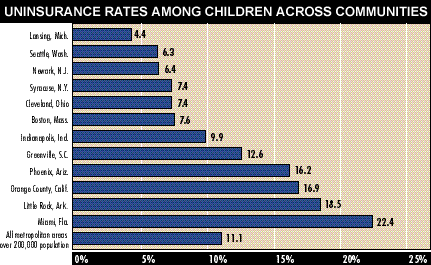
Five-fold Differences in Children's Uninsurance Rates Across Communities, CHIP Implementation Challenges
News Releases
August 4, 1998
FURTHER INFORMATION, CONTACT:
Alwyn Cassil: 202/264-3484
![]() ASHINGTON, D.C. -- Health System Change (HSC), an independent non-partisan research group, released a study today showing a five-fold difference in children’s uninsurance rates across 12 nationally representative communities - with a high of 22.4 percent in Miami, FL and a low of 4.4 percent in Lansing, MI (see table below). HSC researchers attribute these dramatic differences to the lack of employer sponsored coverage, language barriers that may make enrolling children in public programs difficult, changes in immigration and welfare programs and other factors.
ASHINGTON, D.C. -- Health System Change (HSC), an independent non-partisan research group, released a study today showing a five-fold difference in children’s uninsurance rates across 12 nationally representative communities - with a high of 22.4 percent in Miami, FL and a low of 4.4 percent in Lansing, MI (see table below). HSC researchers attribute these dramatic differences to the lack of employer sponsored coverage, language barriers that may make enrolling children in public programs difficult, changes in immigration and welfare programs and other factors.
CHIP, enacted on August 5, 1997, is the largest expansion of health insurance in more than three decades. All states with the exception of Washington and Wyoming, have moved rapidly to develop or are in the process of developing a CHIP implementation plan. Under current state plans, it will expand eligibility for publicly supported insurance to about a third of uninsured children, according to HSC. However, another third of uninsured children will remain ineligible for CHIP or other public programs.

The single most important reason children are uninsured - affecting three out of four children - is that their parents lack access to employer sponsored coverage, either because their parents work for firms that don’t offer health benefits (40%), they aren’t working (21%), or they aren’t eligible for the coverage that is offered (15%). HSC researchers also found that parents who decline coverage for themselves or their dependents (24%) mostly do so because of the cost burden. On average, employees pay 28% of the premium for family coverage, up from 22% in 1991.
"State policy makers are not only grappling with the issues detailed in HSC’s report, but are also working under additional constraints such as restrictions on how much money they can spend on CHIP outreach, and ERISA law that preempts self-insured employers from state-initiated insurance reforms, " said Trish Riley, Executive Director, National Academy for State Health Policy. "This underscores the importance of the state, Federal and local governments working together to reduce the children’s uninsurance rate."
HSC researchers also found that children of Spanish-speaking parents who are not fluent in English are far more likely to be uninsured. "This suggests that language is a major barrier to enrollment, which may also be related to knowledge and acceptance of public programs, " said Paul B. Ginsburg, Ph.D., President of Health System Change. "It may also indicate the effect of more restrictive immigration policy; families may choose not to enroll for fear of deportation."
Based on his research, James D. Reschovsky, Ph.D., who authored the HSC report on CHIP offers state policy makers suggestions on how to overcome some of the implementation challenges they face, namely:
- Refrain from imposing waiting periods for CHIP coverage for children who become uninsured because their parents lose or change jobs;
- Target outreach efforts to unemployment offices and Hispanic social, religious and cultural institutions, as well as doctors’ offices;
- Limit the financial burden for families with respect to sharing the cost of premiums, deductibles and copayments; and
- Cover children for 12 months, even if the children no longer meet eligibility criteria due to changes in family income and other factors.
Other actions states can take to address the problem of uninsured children, include insurance market reforms that limit or eliminate waiting periods for new employees and limit the ability of firms to deny coverage to part-time workers and those with pre-existing conditions.
The HSC report is based on a telephone survey of 33,000 households across the country conducted between July 1996 and July 1997, and is part of a much larger effort by Health System Change to track changes in health care over a multi-year period. HSC also conducts surveys of physicians (12,000) and employer establishments (23,000), as well as intensive case study research in 12 U.S. communities.
Health System Change - a non-partisan research organization funded exclusively by the Robert Wood Johnson Foundation - provides objective analyses about changes in the nation’s health care system and their impact on consumers to private and public decision makers. Health System Change, based in Washington, D.C., is affiliated with Mathematica Policy Research.